Students trace a tragedy online
- Share via
Hiding in his dorm room, Virginia Tech freshman Bryce Carter did what anyone his age would do in a time of crisis -- he blogged.
First he assured friends that he was alive. Then he posted video he shot of police cars gathering outside and still photos of sharpshooters.
“My friends could be dead,” he typed on “Bryce’s Journal,” which is normally dedicated to partying, the environment and Hokies sports. “Tears continue.”
Members of the most wired generation in history dealt with Monday’s bloody rampage by connecting on blogs, Facebook and other websites. Their eyewitness descriptions, photos and video made the trauma unfolding in the rural Virginia town immediate and visceral to millions.
Thousands of miles away, University of Southern California sophomore Charlotte Korchak received a call from her mother in Maryland -- people had been killed at Virginia Tech. Rather than tie up the cellphones of friends at the school, the 19-year-old history major checked their pages on Facebook, the social-networking site.
“I was able to immediately find out who was OK,” she said. “Without Facebook, I have no idea how I would have found that out.”
Every tragedy now seems accompanied by an outpouring of grief and solidarity on the Internet -- a torrent of news, rumor, photos, cellphone videos and instant opinion. So was the case Monday, as the death toll climbed to 33.
For many college students, this could become their defining tragedy. Most were only in grade school or middle school during the Columbine High School massacres of 1999 and the Sept. 11 terrorist attacks two years later.
By Monday evening, more than 16,000 had flocked to Facebook’s “April 16, 2007 -- A Moment of Silence” discussion group. Other impromptu memorial groups drew thousands of members each.
“Since the launching of Facebook, there’s probably nothing that has impacted the college audience as this has,” said Brandee Barker, a spokeswoman for the 3-year-old site.
On Monday, TechSideline.com, a website for fans of Virginia Tech sports, turned into a meeting place where visitors could seek word about loved ones.
“It allows you to feel closer to the situation,” said Robert Niles, editor of USC’s Online Journalism Review and a former Rocky Mountain News reporter who covered the Columbine killings. “To see that there is a functioning community is very reassuring to people who are disturbed by something as horrible as this.”
As the story broke, users of Digg, a popular news-sharing site, posted stories by CNN and ABC News, then returned to those posts all day to share fatality counts, warm wishes to survivors, condolences to families of the dead and links to a cellphone video recorded by a Virginia Tech student outside Norris Hall as the shooting happened.
“What this link became was a place to learn what happened in the last five minutes,” said Jay Adelson, chief executive of San Francisco-based Digg.
Anthony Le, 19, a civil engineering student at Virginia Tech, kept his ear to a police scanner all morning as the drama unfolded, then posted whatever information he learned on Digg.
“The count of the fatalities was a lot slower on CNN than on Digg,” Le said.
Carter, 18, left class shortly before 10 a.m., saw police cars and wondered what was brewing. A message began blaring over the campus loudspeaker: “This is an emergency. Take shelter indoors immediately. Stay away from windows and remain inside.”
Gunshots sounded. Carter headed for his dorm.
He managed to make two calls before the cellphone networks jammed. He sent instant messages to friends on the other side of campus.
“We didn’t know anything,” Carter said. “So we kept trying to find out things online.”
He began to blog. At 10:48, he posted the photos and a quick account of the morning’s events. An hour later he posted video he shot on his digital camera. Soon, the death toll began to emerge.
“We topped Columbine,” he wrote at 12:40. “Please God, have none of them be my friends.”
Carter’s firsthand account, linked to by latimes.com and many other websites, drew dozens of comments.
“I just tried to share my story with friends, what it’s like to be here,” Carter said in an interview.
Reporters seeking interviews began to post messages on Carter’s blog. Some of his readers objected, calling the journalists “vultures.”
Timothy Campbell, a forensic scientist in Toronto, posted encouragement, telling Carter, “Everyone is watching.”
“I like to get a mixed viewpoint, both from big media, which can be detached, and from Bryce, who’s intimately connected with the event,” Campbell said.
By the end of the day, Carter said he had heard from countless friends and strangers. With phone lines flooded, they contacted him via instant messenger, e-mail, Facebook and other electronic methods.
“My postings are simply what I always do,” he wrote, “except I left my thoughts for the public instead of just my friends.”
*
alex.pham@latimes.com
Times staff writer Tony Barboza contributed to this story.






